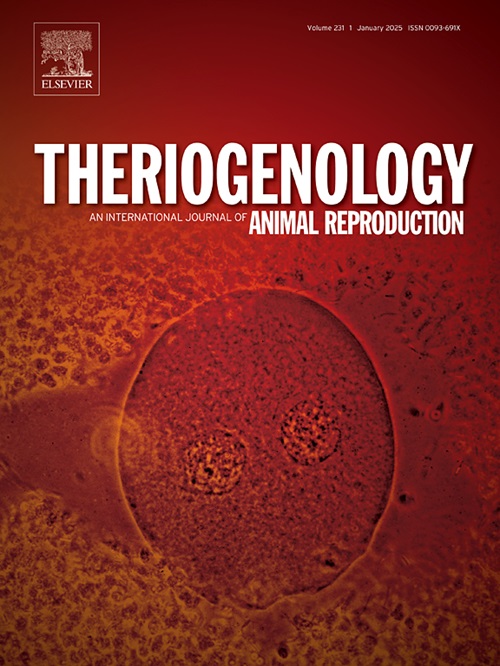Specificity protein 1 (SP1) plays an essential role in early bovine embryo development
IF 2.4
2区 农林科学
Q3 REPRODUCTIVE BIOLOGY
引用次数: 0
Abstract
A previous RNA-Seq study revealed that the transcript abundance of specificity protein 1 (SP1) was significantly higher in Day 7 bovine blastocysts compared to conceptuses on Days 10, 13, 16, and 19, suggesting a stage-specific role in early bovine embryo development. The present study aimed to characterize the mRNA expression of SP1 and associated candidate genes (ACSS1, C1QBP, ATF3, MAT2A, and POLD1) during early bovine embryo development from the 2-cell to blastocyst stage. Further, the effects of SP1 inhibition on embryo development were evaluated by culturing embryos with the SP1 inhibitor, mithramycin A (MT) at varying concentrations (0, 25, 50, 100, and 1000 nM). As further validation, we examined expression of SP1 and associated genes by interrogating transcriptomic data from Day 4 (16-cell stage) embryos cultured in vitro or in vivo in the oviducts of lactating or nonlactating dairy cows. The relative abundance of SP1 peaked at the time of embryonic genome activation, being higher (P < 0.05) in 8- and 16-cell embryos compared to the 2-cell stage, and decreasing thereafter (at the morula and blastocyst stages). Similarly, transcript abundance for most of the selected candidate genes involved in the SP1 network were upregulated (P < 0.05) at the 8- and 16-cell stage, but not at other stages investigated. Inhibition of SP1 with MT did not affect embryo development up to the 8-cell stage but reduced (P < 0.05) the proportion of embryos reaching the 16-cell and blastocyst stages in a dose-dependent manner. Moreover, blastocysts produced in the presence of MT contained fewer (P < 0.05) cells than blastocysts developed without MT. Expression of SP1 and associated genes in 16-cell stage (Day 4) embryos produced either in vitro or in vivo was higher (P < 0.05) compared to in vitro-produced 2- to 4- cell stage (Day 2) embryos. These findings suggest an essential role of SP1 during early embryo development, particularly around the time of embryonic genomic activation.
特异性蛋白1 (SP1)在牛早期胚胎发育中起重要作用
先前的RNA-Seq研究表明,特异性蛋白1 (SP1)在第7天的牛囊胚中的转录丰度明显高于第10、13、16和19天的胚胎,这表明SP1在早期牛胚胎发育中具有阶段特异性作用。本研究旨在研究SP1及其相关候选基因(ACSS1、C1QBP、ATF3、MAT2A和POLD1)在早期牛胚胎从2细胞发育到囊胚阶段的mRNA表达。此外,通过用SP1抑制剂米霉素A (MT)在不同浓度(0、25、50、100和1000 nM)下培养胚胎,评估SP1抑制对胚胎发育的影响。为了进一步验证SP1和相关基因的表达,我们对体外或体内培养的第4天(16细胞期)胚胎在泌乳或非泌乳奶牛的输卵管中的转录组学数据进行了研究。SP1的相对丰度在胚胎基因组激活时达到峰值,较高(P <;0.05),此后(桑葚胚期和囊胚期)呈下降趋势。同样,SP1网络中大多数候选基因的转录物丰度上调(P <;0.05),在8和16细胞阶段,但在其他阶段没有。MT对SP1的抑制不影响胚胎发育直至8细胞期,但降低了(P <;0.05)达到16细胞期和囊胚期的胚胎比例呈剂量依赖性。此外,在MT存在下产生的囊胚含有较少的(P <;SP1及其相关基因在体外和体内16细胞期(第4天)胚胎中的表达均较高(P <;0.05)与体外产生的2- 4细胞阶段(第2天)胚胎相比。这些发现表明SP1在早期胚胎发育中,特别是在胚胎基因组激活的时候起着重要的作用。
本文章由计算机程序翻译,如有差异,请以英文原文为准。
求助全文
约1分钟内获得全文
求助全文
来源期刊

Theriogenology
农林科学-生殖生物学
CiteScore
5.50
自引率
14.30%
发文量
387
审稿时长
72 days
期刊介绍:
Theriogenology provides an international forum for researchers, clinicians, and industry professionals in animal reproductive biology. This acclaimed journal publishes articles on a wide range of topics in reproductive and developmental biology, of domestic mammal, avian, and aquatic species as well as wild species which are the object of veterinary care in research or conservation programs.
 求助内容:
求助内容: 应助结果提醒方式:
应助结果提醒方式:


